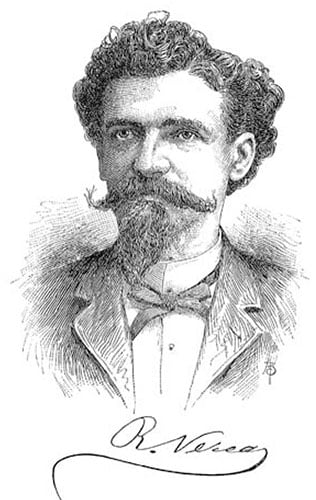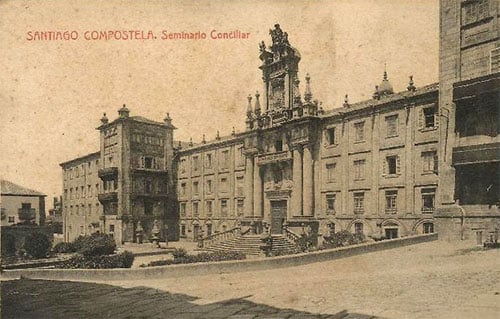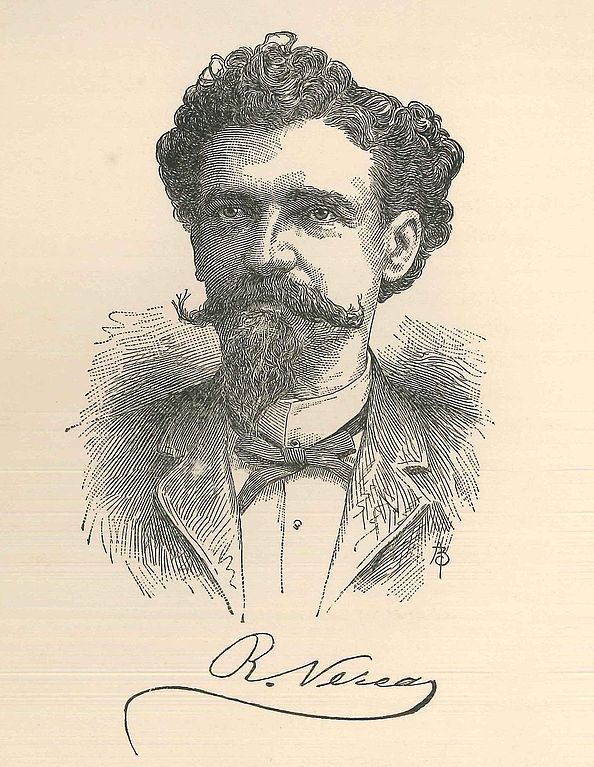
Who was Ramon Verea?
Ramón Silvestre Verea Aguiar y García was a Spanish-born Hispanic inventor and author.
Early Life
Born December 11th, 1833, to Spanish parents Juan Verea Filloy and Florentina García de Porto, he grew up on the family farm in Esmorís, parish San Miguel de Curantes, Pontevedra. Although it has been restored throughout time, the original house still stands. Ramón’s early life consisted of being tutored by his uncle and local priest of Curantes, Francisco de Porto. Francisco was an educated man with a large library, which aided in Ramón’s education. Then in 1847 Ramón began his pursuit of a career in literature at the University of Santiago de Compostela’s Faculty of Philosophy and Letters.
Career
In 1849 Francisco de Porto’s wish was granted as Ramón left the Faculty of Philosophy and Letters to join the University of Santiago de Compostela’s Seminario Conciliar, where Ramón began his path to priesthood. Ramón stayed the course until 1854, earning high marks in philosophy, metaphysics, Hebrew, and other courses. One could say Ramón had an inquisitive mind, as he enjoyed both reading and studying how things worked. It was this love for determining how things worked that caused Ramón to rethink his religious studies.
Ramón was more interested in scientific facts than philosophical ideas, and began his adult life in 1855 Cuba as a teacher in Sagua la Grande, then in Colóne. During his time in Colóne he wrote two novels. Ramón wrote about new machines, structures like the Brooklyn Bridge, and even early concepts for submarines. Ramón even wrote about his dissatisfaction with Spain; he thought Spain had wasted all the wealth the country gained from their colonization of Mexico in the 1500’s and was upset with the lack of innovation in the country.

Ramón’s first mechanical innovation came to life in 1863. During his time in Cuba he created a machine to fold the newspapers he was publishing. This invention was later sold to a New Yorker, as Ramón lacked the capital to acquire additional copies of the machine, or a patent. In 1865 Ramón moved to Puerto Rico for a short while just before finally landing in New York City. Once he got to the Big Apple, Ramón began continued writing by contributing to a local Spanish newspaper as well as teaching and translating Spanish. During this time his love for inventions and innovations remained, and followed him back to Cuba in 1867 when Ramón moved to Havana. Ramón would go on to spend eight years in Havana trying to introduce his machine and others to the local population.
After 8 years Verea returned to New York City with his savings and new knowledge and ideas, and became the founder of the Industrial Agency for the Purchase of Machinery and Effects of Modern Invention in 1875. It was at this time Verea created his most well-known invention, a machine which used a new method to multiply numbers. Previous multiplication machines simply added a number the amount of times needed to reach the right answer, but Ramón’s was a direct multiplication calculator (see the direct calculating machine of Ramon Verea). For example, previous calculators would solve 13 times 22 by setting the machine to 13, then moving it twice, shifting, then moving again to finish the calculation. This new direct multiplication machine used a ten-sided cylinder to complete the calculation with one motion. At the same time of his invention, Ramón was also working as a director for the Spanish newspaper El Cronista.

In spite of this revolutionary new invention, Ramón was no Thomas Edison. It seems as though the calculator was his only noteworthy invention. After spending a few years in New York City, Ramón traveled back home to Spain in 1879 only to find his hometown or Curantes much the same as he left it, with little progress having been made. It was this disappointment that caused him to leave Spain for New York City once more just two years later. A year into his return to the big city Ramón had created his own publication, The Polyglottis. Ramón stayed in the city until 1895 when his disapproval of the United States’ actions in Cuba and the Philippines caused him to leave for Guatemala. It was in Guatemala Ramón wrote his books La Defensa De España and La Cuestión De Cuba. In addition to these books, Verea began another Spanish publication called El Progreso in 1898 where he advocated for scientific advancements and technical innovations.
What did Ramon Verea Do?
Calculator
Ramón Verea invented the world’s first single-motion calculator that could solve complex multiplications as a whole. At the time all previous calculators were only able to multiply several numbers by doing so one at a time.
Publications
Ramón also wrote for several newspapers and publications. He also started his own publication, El Progreso. Additionally, Ramón published two novels: La Defensa De España and La Cuestión De Cuba.
Ramon Verea: Marriage, Divorce, Children, and Personal Life
Net Worth
Although his time in Cuba allowed him to save money, it’s unclear just how much Verea’s work had earned him throughout his lifetime.
Marriage
Ramón Verea was never married or even publicly involved with anyone, nor did he have children.
Ramon Verea: Awards and Achievements
Verea did accomplish many things in his life, including inventing a direct calculator, writing for several publications, starting his own publication, and writing two books. However it does not seem as though any of his works earned any awards or much recognition.
Ramon Verea: Published Works and Books
El Cronista
Spanish-English news.
El Progreso
A biweekly publication discussing science and technology.
The Polyglottis
Not much is known about this publication.
La Defensa De España
While not much is known about this book, one could assume Verea discussed Spain’s shortcomings and strengths, since this was written around the time of his voiced disdain for the way Spain hadn’t made as many technological advancements as other countries had done.
La Cuestión De Cuba
While not much is known about this book, it was likely a continuation of La Defensa De España, where he would have discussed Cuba’s future and highlighted similarities and differences between Cuba and Spain.
The image featured at the top of this post is ©Public domain, via Wikimedia Commons.


